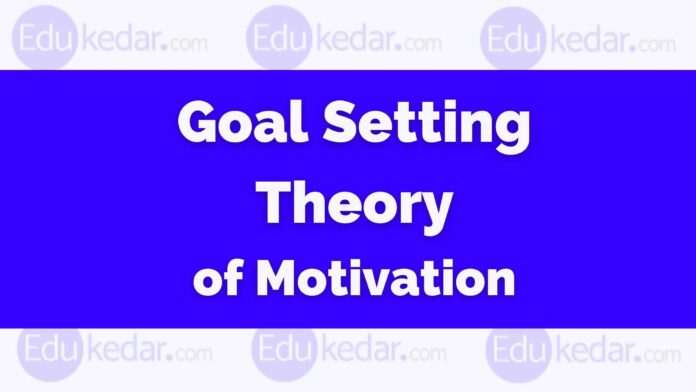The goal-setting theory of motivation helps us in understand how individuals feel motivated by setting well-defined or SMART goals, getting constructive feedback from superiors, and how goal setting is directly linked to improved performance, increased output, increased commitment, and positive organizational culture.
The accomplishment of goals is a very crucial factor to determine the motivation level of an individual, goals provide a path or direction to an employee about what needs to be done and how much effort is required to be put in.
In this article, we will discuss comprehensively the concept of goal setting theory of motivation and its principles, Smart goals, examples, and importance.
► What is the Goal Setting Theory of Motivation?
The goal-setting theory was proposed by Edwin Locke in the late 1960s.
The goal-setting theory of motivation advocates that the goals of an individual or group are directly linked to task performance and goals provide direction to workers about what needs to be accomplished by them.
The difficult goals have greater motivating factors than easy and general goals.
This theory also focuses on how specific and challenging goals along with appropriate feedback from superiors contribute to enhancing the task performance of employees and boosting their motivation level.
► Principles of the goal-setting theory
According to Locke’s goal-setting theory, there are five main principles.
- Clarity
- Challenge
- Commitment
- Feedback
- Task Complexity
✔ Clarity
Goals should be clear and specific. If goals are clear and specific then relate to higher performance in completion and reduce the chance of misunderstanding. When employees understand project objectives and deadlines, there is much less risk of misunderstandings.
✔ Challenge
Goals should be set as challenging to keep employees motivated, and focused and put more effort while performing the tasks so he or they can achieve each goal. If an organization or manager set too tedious or easy goals for an employee that have a demotivating effect on the employee’s behavior it results in less achievement satisfaction.
✔ Commitment
If an individual is committed to the achievement of goals then they will not leave it before achieving it. If an employee is committed to the goal, then he or she understands, supports, and definitely enjoys the process of achieving the goal.
✔ Feedback
Feedback is a vital part of the goal-setting theory. Employees should receive regular feedback from their superiors or mentors so that they stay on track to reach the goal.
✔ Task Complexity
It means the degree of complicated actions needed to be required by the performer to accomplish the task. Complex or demanding task push harder to reach the goals.
► Steps in Implementation of Goal-setting Theory
The steps that help in the implementation of the goal-setting theory in the workplace are given below and these steps include:
- Decide the purpose of the goal
- Communicate with the employee
- Develop a plan using the SMART model
- Allocate the required resources
- Provide regular feedback
✔ 1. Decide the Purpose of the Goal
The first step of the implementation process is to decide what is the purpose goal and what is organization aim to achieve after the completion of goals. The purpose goal should be clear and specific to both management and employees.
✔ 2. Communicate with the Employee
After deciding the purpose of the goal, the organization should communicate with employee’s ask for their opinion about the goal. This step is very crucial for employees to participate in the setting of their goals and understands their roles and responsibilities in terms of accomplishing the goal.
✔ 3. Develop a Plan using the SMART Goal
The organization used the SMART model for setting and accomplishing goals. A SMART is carefully planned and has trackable objectives. A SMART is an acronym that stands for Specific, Measurable, Aggressive, Realistic, and Time-bound.
SMART Goals meaning in a detailed manner explained below.
- Specific
- Measurable
- Aggressive
- Realistic
- Time-bound
Specific- means that the goal should be well-defined, clear, and unambiguous.
Example – Instead of saying the goal is to increase sales, the manager should set a specific goal, such as increasing sales by 15% over the financial year.
Measurable – It means measuring employee progress toward the accomplishment of the goal.
Achievable – Goals should be fairly challenging and attainable. The goals being set are slightly higher than an employee’s skill set so he or she keeps pushing hard to achieve the goal.
Realistic – It means that goal should be reachable and relevant to both employee and management objectives.
Time-bound- Goals should have a clear timeline in which they need to be reached. It is important to create a sense of urgency.
✔ 4. Allocate the Required Resources
The organization should provide all required resources, equipment, time, and information needed by employees to accomplish the goal. It ensures the faster, more effective, and more efficient completion of tasks.
✔ 5. Provide Regular Feedback
It is the duty of superiors or managers to meet with the employee on a regular basis to check their progress, review their action plan, discuss the results achieved and provide constructive feedback that helps the employee to improve.
► Importance of Goal-setting Theory
Also Read :Process of Motivation
Other Theories of Motivation
- Vroom Expectancy Theory
- Path Goal Theory of Motivation
- Adam’s Equity Theory of Motivation
- Herzberg’s Two-Factor Theory of Motivation
- Theory X Theory Y by Douglas McGregor





